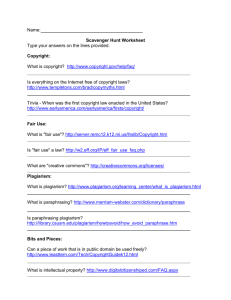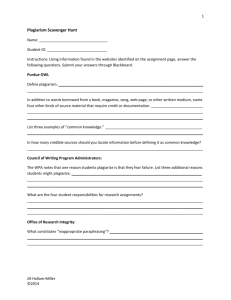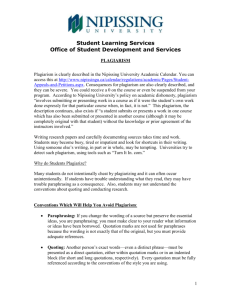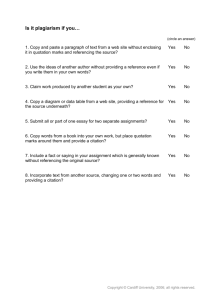Avoiding Plagiarism - Los Angeles Mission College
advertisement
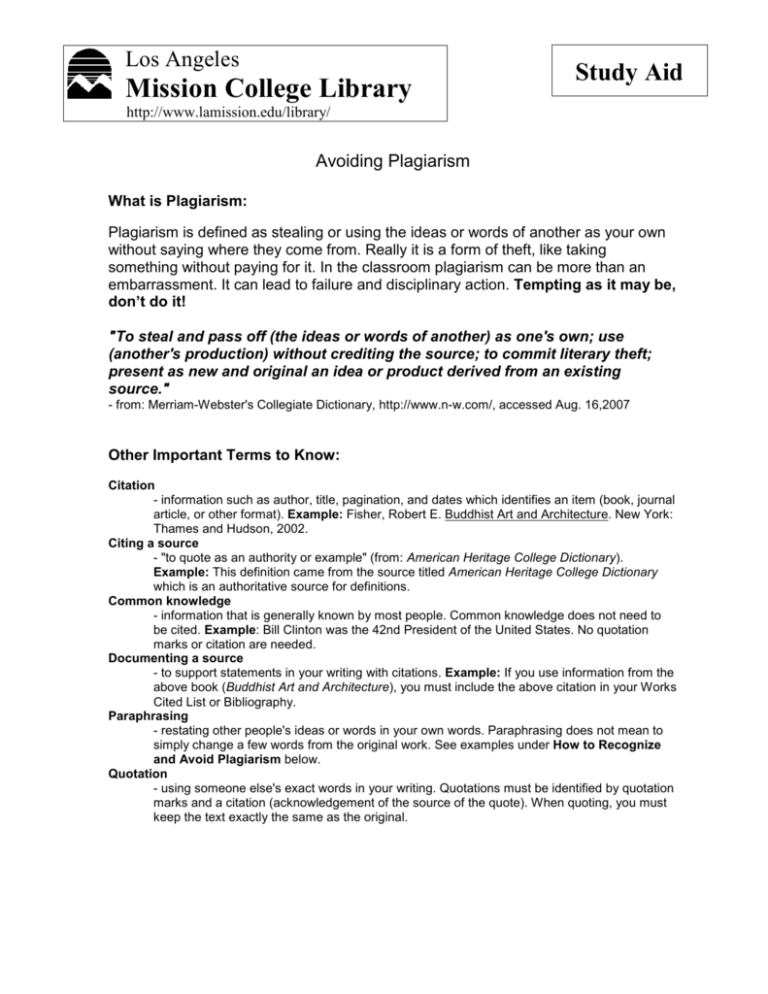
Los Angeles Mission College Library Study Aid http://www.lamission.edu/library/ Avoiding Plagiarism What is Plagiarism: Plagiarism is defined as stealing or using the ideas or words of another as your own without saying where they come from. Really it is a form of theft, like taking something without paying for it. In the classroom plagiarism can be more than an embarrassment. It can lead to failure and disciplinary action. Tempting as it may be, don’t do it! "To steal and pass off (the ideas or words of another) as one's own; use (another's production) without crediting the source; to commit literary theft; present as new and original an idea or product derived from an existing source." - from: Merriam-Webster's Collegiate Dictionary, http://www.n-w.com/, accessed Aug. 16,2007 Other Important Terms to Know: Citation - information such as author, title, pagination, and dates which identifies an item (book, journal article, or other format). Example: Fisher, Robert E. Buddhist Art and Architecture. New York: Thames and Hudson, 2002. Citing a source - "to quote as an authority or example" (from: American Heritage College Dictionary). Example: This definition came from the source titled American Heritage College Dictionary which is an authoritative source for definitions. Common knowledge - information that is generally known by most people. Common knowledge does not need to be cited. Example: Bill Clinton was the 42nd President of the United States. No quotation marks or citation are needed. Documenting a source - to support statements in your writing with citations. Example: If you use information from the above book (Buddhist Art and Architecture), you must include the above citation in your Works Cited List or Bibliography. Paraphrasing - restating other people's ideas or words in your own words. Paraphrasing does not mean to simply change a few words from the original work. See examples under How to Recognize and Avoid Plagiarism below. Quotation - using someone else's exact words in your writing. Quotations must be identified by quotation marks and a citation (acknowledgement of the source of the quote). When quoting, you must keep the text exactly the same as the original. How to Recognize and Avoid Plagiarism: Paraphrasing Original Text (from The Pursuit of Oblivion: A Global History of Narcotics by Richard Davenport-Hines, 2002). The prohibition policies of the USA have escalated into the global Wars on Drugs associated since 1969 with the Nixon, Reagan and Bush administrations. The American approach can be summarized as requiring unconditional surrender from traffickers, dealers, addicts and occasional recreational users. The prohibitive policies in the United States have become the worldwide Wars on Drugs associated since 1969 with the Nixon, Plagiarism Reagan and Bush administrations. The American way of dealing with (Unacceptable Paraphrase) things can be summarized as requiring complete surrender from dealers, addicts, traffickers and occasional recreational drug users. 1. Only a few words were changed or the order of words was altered. Why is it plagiarism? 2. The source of the text is not cited. Acceptable Paraphrase Drug policies in the United States emphasize prohibition at all levels: traffickers, dealers, addicts and occasional recreational users. Although these policies originated in the US, particularly with Republican administrations of the last 30 years, they have grown into the "global Wars on Drugs" (Davenport-Hines 15). 1. The passage was rewritten in the writer's own words while maintaining the meaning of the original text. 2. The source of the text is cited. Why is it acceptable? Note: You can use paraphrase and quotations together. This is particularly useful for phrases which you don't wish to reword because that would alter the meaning. How to Recognize and Avoid Plagiarism: Quoting Original Text (from Becoming Evil: How Ordinary People Commit Genocide and Mass Killing by James Waller, 2002). Unacceptable Quote Why is it plagiarism? In 1492, it is estimated that well over 100 million indigenous people inhabited the Western hemisphere. Two centuries later, it is estimated that the indigenous population of the Americas had been diminished by some 90 percent and was continuing to fall steadily. "In 1492, it is estimated that well over 100 million indigenous people inhabited the Western hemisphere. Two centuries later the population of the Americas had been diminished by 90 percent." 1. The passage has not been quoted accurately. 2. The source of the quotation is not cited. Although it is thought that there were more than 100 million native inhabitants in the Western hemisphere in 1492,"two centuries later, it is estimated that Acceptable quotation the indigenous population of the Americas had been diminished by some 90 percent and was continuing to fall steadily" (Waller, 37). 1. The first part of the sentence is an acceptable paraphrase. 2. The second part of the sentence is quoted accurately. Why is it acceptable? 3. The whole passage is cited. Avoid plagiarism by developing good research methods and following some basic rules of writing and documentation. As you research: • • • Keep track of the sources you use. Accurately record the author, title, publisher, date, including the page numbers from which your notes were taken. You will need this information to document your source correctly. In your notes be careful to make the distinction between your own ideas and the ideas of others. If you copy exact quotations from the text, make it clear in your notes that it is a quotation, either by the use of quotation marks, or highlighting, or a big "Q" in the margin. As you write: • • • • When paraphrasing, read over the material that you want to paraphrase; then close the source. Without looking back at the original, write out the idea in your own words. Next, check your version against the original for accuracy and mistakenly borrowed phrases. When paraphrasing, consider beginning your statement by giving credit to the author of your source. Example: According to the historian, Lynn Hunt, . . . When quoting, you can mention the author's name at the beginning or at the end of the quote. If there is a word or phrase used by an author that you think is unique and essential to the meaning of the source, put it in quotations and cite it. As you proofread: • • • Be certain that you have accurately and completely documented all material from other sources. Check direct quotations against the original source to be sure that they are accurate. Double check paraphrased material to make sure that your words and sentence structure are different than the original source. To Cite or not to Cite? By now it must seem that you have to document every sentence you write. Here's a table that will help you decide. Needs Documentation When you use or refer to someone else's words or ideas whether from a printed source (book, magazine, etc.), the internet, television, advertisement, movie, or any other medium. When you use information from an interview with another person. NO Documentation Needed When you are writing about your own experiences, observations, opinions, conclusions, etc. When you are using "common knowledge"--that is, information that most people know. It might be common sense observation, folklore, shared knowledge, etc. When you use statistics, diagrams, factual data from When you are stating generally accepted facts. another source. When you use ideas that others have given you in When you are reporting the results of your own conversation or by email. experimental work or primary research. These sources were used in creating this document: Avoiding Plagiarism. Purdue University Online Writing Lab. 12 February 2003. Web. 4 Sept. 2007. Gordon, Colin H., Peter Simmons, Graeme Wynn and the Faculty of Arts. Plagiarism: What It is, and How to Avoid It. The University of British Columbia. n.d. Web. 4 Sept. 2007. Plagiarism: What It is and How to Recognize and Avoid It. Writing Tutorial Services, Indiana University. n.d. Web. 4 Sept. 2007. Adapted with permission from Glendale Community College. Updated 9/4/2007

